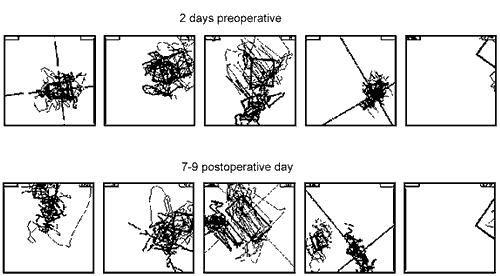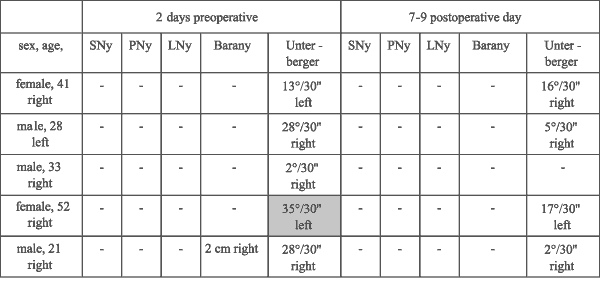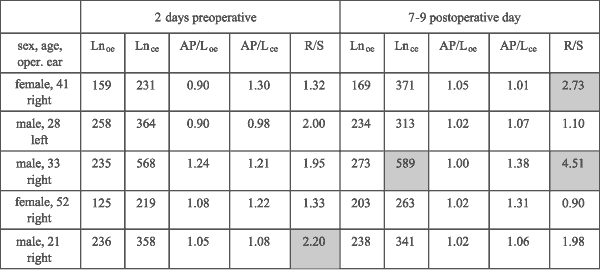

|
Journal Home Contents Preview Next |
Pro Otology
Balkan Journal of Otology & Neuro-Otology, Vol. 3, No 2—3:90—93 © 2003
All rights reserved. Published by Pro Otology Association
Postoperative Vestibular Symptoms in Patients with Stapedial Otosclerosis. Preliminary Report
*D. Petrova, †G. Edrev, †,*†St. Lolov
*Department Neurology Neuro-Otology,
†Department Otorhinolaryngology, “Tzar Boris III” Hospital;
*†Institute Biology Immunology Reproduce, Bulgarian Academy of Science, Sofia, Bulgaria
ABSTRACT
Objective: The purpose of this study is to compare the spontaneous vestibular symptoms before and early after stapedotomy.
Study Design: This is s a retrospective and prospective study.
Settings: The study was performed in the Otolaryngology clinic at the National Transport Hospital “Tzar Boris III”.
Patients: 181 consecutive cases of surgically confirmed stapedial otosclerosis; 5 cases studied in details.
Interventions: Small fenestra stapedotomy with piston implantation.
Main Outcome Measures: Subjective complains; preoperative and postoperative neurotological testing.
Results: Preoperatively there were no objective spontaneous vestibular symptoms. Postoperative vestibular complaints were more common among patients with relatively longer prosthesis. There were deviations only in separate values with no correlation in the direction of the operated ear in the period of 7-9 days after the operative intervention.
Conclusions: The frequency of subjective vestibular symptoms in our series of proven stapedial otosclerosis is not high. Vestibular symptoms in otosclerosis are mostly among patients with cochlear damage.
Key words: Stapedial otosclerosis, Vestibular symptoms, Stapedotomy.
Pro Otology 2-3: 90-93, 2003
Introduction
Two main factors have an effect upon vestibular functions in otosclerosis – damaging of the peripheral end organ as a result of the otosclerotic process and operative work in immediate vicinity to the labyrinth. There are a lot literature data about correlation between cochlear form of the disease and vestibular damage. At the same time the majority of these patients has not undertaken an operative treatment.
In stapedial form of otosclerosis the aim of the operation is to correct only the stapedio-vestibular ankylosis without damaging the delicate structures of the inner ear. Usually these are cases without or with minimal preoperative cochlear damage. The purpose to avoid any operative trauma leads to our interest towards frequency and quality of postoperative vestibular symptoms. Together with the hearing improvement, the subjective evaluation of patients about the result of intervention is based on postoperative changes in balance and vegetative complaints, taste, presence of tinnitus and sound quality .
The AIM of this study is to compare the spontaneous vestibular symptoms before and after stapedotomia. The article represents also the initial results of the analysis of five closely observed cases and the comparison with clinical observations of 181 persons during the period 1996-2000.
Methods
After careful neurologic history, by using Frenzel’s glasses we made an investigation for spontaneous (Sny), latent (Lny) and positional nystagmus (Pny), as we recorded its level, direction, form, associativity, duration, frequency and amplitude. A special attention was paid to the so-called latent nystagmus, which manifests during head nodding and is a sign of vestibular dysfunction, characterizing mainly the condition of the vestibular subcompensation.
The finger-nose test of Barany was performed for 30 s – quantitatively (cm) and qualitatively (direction and character) and for asymmetry we accepted diversions in one direction above 3 cm. We recorded the results of Unterberger’s test by an electromagnetic detector for direction, fixed by a belt on the patient’s waist as a part of the automated system U-01/90. For the evaluation of dynamics in equilibrium, the gradient of the process was registered every 5 sec in angle °/s. According to the referent values of the apparatus we considered deviations above 30°/30 s in the respective direction as significant.
Static stabilography was performed using the apparatus “Test V” with a platform with automatic weight detection (FIG. 1). With the eyes of the patient open (“oe” index) and closed (“ce” index), we evaluated the indices - way of center of gravity (Lnoe and Lnce), the correlation of anterior-posterior to lateral diversions (AP/Loe and AP/Lce) and Romberg coefficient (R/S). These parameters do not correlate significantly to the age and allow detection of pathology with obvious age dependence .

|
|
FIG 1. Results of nystagmus observation, Barany and Unterberger's tests, made pre- and postoperative in patients operated because of a stapedial otosclerosis. (The abbreviations are given in the main text). |
Results
Only single data are outside normal limits and there are no reasons to suggest the presence of objective spontaneous vestibular symptoms preoperatively among patients with surgically proven stapedial otosclerosis. Patient’s accumulation is now in progress to reach statistical significance of this conclusion.
Right after completing the general anesthesia, about ¼ of the operated patients had slight vestibular and vegetative complaints (vertigo, nausea, sweating), nystagmus directed towards the operated ear, which very seldom (1/10) needs treatment. As it can be seen in the tables 1 and 2, there is again deviation only in separate values, with no correlation in the direction of the operated ear in the 7-9 days’ postoperative period. These data suppose that our stapedotomy technique is gentle and has only short-term, postoperative peripheral vestibular effect.
| Table 1. Results of nystagmus observation, Barany and Unterberger's tests, made pre- and postoperative in patients operated because of a stapedial otosclerosis. (The abbreviations are given in the main text). |

|
| Table 2. Results of the preoperative and postoperative stabilographic examination of patients, operated because of stapedial otosclerosis. The data in the hatched area is out the referent values of the stabilograph used by us. (The abbreviations are given in the main text). |

|
Discussion
In the past, postoperative vestibular manifestations have been compulsory findings when using different variants of fenestration. According to an interesting observation of Stoyanov et al. nowadays stapedoplasty leads to single cases of postoperative spontaneous nystagmus, found up to the 7th day . The percentage of the latent nystagmus is considerable – it is observed among 14% of the examined persons on the 7th postoperative day, which is comparable to the preoperative level of 12%.
Postoperative vestibular complaints are more common among patients with relatively longer prosthesis. Physiological vibrations of the stapes are in the range of nanometers and the longer piston irritates sacculus only during the intraoperative testing of the chain mobility.
In the two cases with more pronounced early postoperative vestibular symptoms it probably concerned a small early perilymph fistula. According to Goodhill this condition is much more common than it is supposed. We reached control of this condition and stable hearing without revision with bed rest, antiemetic means and dehydration therapy for a week.
Discussing the good end results of stapedotomy performed, we must emphasize upon the lack of postoperative complications in the small number of patients with preoperative vestibular complaints and the positive effect of the intervention upon the vestibular symptoms.
In the past, probably because of more traumatic procedures used, the presence of vestibular symptoms, especially those of fitting character as Meniere’s disease was considered a reason for complications in the postoperative period, both in the vestibular apparatus and in the cochlea. The disturbed caloric response of the operated ear may be improved in a period of an year after the intervention with persistent subjective symptoms for 3-4 weeks and a higher risk for vestibular damage after second ear operation. According to the above-mentioned authors the main cause for vestibular and sensineural damage is the decreased distance between the stirrup basal lamina and the swelled by the hydrops sacculus.
In 1969 Black reported about the lasting positive effect of the stapedotomy upon the preoperative vestibular symptoms. Issa et al. supported this opinion – “stapedectomy does not increase the risk of sensorineural hearing loss for patients with otosclerosis and Meniere’s disease”. Ghorayeb and Linthicum reached disappearance of the preoperative vertigo in 23 of 27 patients with clinical otosclerosis after stapedectomy.
According to Houck and Harker it is better the preoperative vestibular symptoms to be taken into consideration during decision which ear to be operated when there is bilateral otosclerosis. In primary cases with electronystagmographic data, it is better the more damaged ear to be operated and if there is a postoperative worsening of the vestibular functions the other ear to compensates. If the above–mentioned case is realized, the second ear should not be operated because of the danger of permanent balance disorder .
Conclusion
There are no vestibular complaints in the classical Bezold’s triad. In our series of proven stapedial otosclerosis the frequency of subjective vestibular symptoms is not high. This is in full conformity with a lot of scientific reports, where no matter the emphasized differences in percentage and methods of investigation the following conclusion is established: vestibular symptoms in otosclerosis are mostly among patients with cochlear damage. Our initial results of the detailed neuro-otological investigation before and after operation confirm sparing the inner ear character of the used operative procedure. This allows us to join the authors who recommend an operative treatment also in patients with short lasting vestibular damages.
REFERENCES
Saim L, Nadol JB, Jr. Vestibular symptoms in otosclerosis--correlation of otosclerotic involvement of vestibular apparatus and Scarpa's ganglion cell count. Am J Otol 1996;17(2):263-70.
Virolainen E. Vestibular disturbances in clinical otosclerosis. Acta Otolaryngol Suppl 1972;306:1-34.
Chiong CM, Xu WZ, Glynn RJ, Nadol JB, Jr. Survival of Scarpa's ganglion in the profoundly deaf human. Ann Otol Rhinol Laryngol 1993;102(6):425-8.
Ramsay H, Karkkainen J, Palva T. Success in surgery for otosclerosis: hearing improvement and other indicators. Am J Otolaryngol 1997;18(1):23-8.
Shirov O. Normal age-related changes in vestibular functions. Otorhinolaryngology (Bulg) 1997;1(1):33-5.
Shambaugh GE, Jr, Wiet RJ. The fenestration operation in 1979. Am J Otol 1979;1(1):1-6.
Stoyanov S, Despotov O, Karchev T, Dimov E. First results from the study of vestibular function of patients with middle ear operations. Bulg Otorhinolaryngology 2002;1(2):29-32.
Causse JB, Gherini S, Lopez A et al. Impedance transfer: acoustic impedance of the annular ligament and stapedial tendon reconstruction in otosclerosis surgery. Am J Otol 1993;14(6):613-7.
Goodhill V. Surgical treatment of otosclerosis. In: English GM, editor. Otolaryngology: J.B.Lippincott Comp, 1979:1-11.
Smyth GD, Kerr AG, Singh KP. Second ear stapedectomy - a continued controversy. J Laryngol Otol 1975;89(10):1047-56.
Zdravkov O. Otosclerosis. Sofia; 1998:22-30.
Black FO, Sando I, Hildyard VH, Hemenway WG. Bilateral multiple otosclerotic foci and endolymphatic hydrops, histopathological case report. Ann Otol Rhinol Laryngol 1969;78(5):1062-73.
Issa TK, Bahgat MA, Linthicum FH, Jr., House HP. The effect of stapedectomy on hearing of patients with otosclerosis and Meniere's disease. Am J Otol 1983;4(4):323-6.
Ghorayeb BY, Linthicum FH, Jr. Otosclerotic inner ear syndrome. Ann Otol Rhinol Laryngol 1978;87(1 Pt 1):85-90.
Houck JR, Harker LA. Otosclerosis-diagnosis and nonsurgical management. In: Cummings CW, Harker LA, eds. Otolaryngology - Head and Neck Surgery. St.Louis, Toronto: C.V.Mosby Company; 1986:3095-112.
|
Pro Otology |
Journal Home Contents Preview Next |